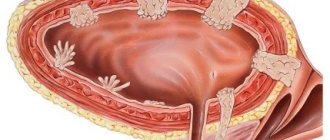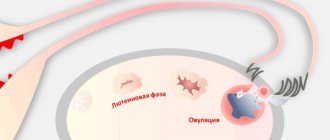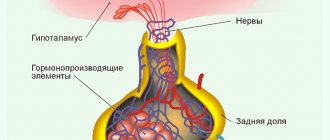Menstrual cycle is normal
Normally, the duration of the menstrual cycle ranges from 21 to 35 days.
According to statistics, for about three out of four women it lasts 28 days. Menstruation can last from 3 to 7 days. On average, blood loss is about 80 ml of blood in each cycle (on average about 35). The duration of the follicular phase of the cycle ranges from one week to 22 days (on average 14 days), the luteal phase – 13-15 days. Typically, changes in cycle length are associated with a shorter or longer first phase, during which the follicles containing the egg grow.
The first menstruation (menarche) usually occurs at the age of 12-13 years, although both 10 and 17 years are considered normal. The time of the onset of the first menstruation depends on genetic factors (in about half of the cases, menarche occurs at the same age as the mother), climate, nationality, and social and living conditions.
For most girls, the menstrual cycle does not become regular immediately; sometimes it takes several months, sometimes more than a year. Several years before the onset of menopause (during premenopause), changes in the regularity of the cycle are also observed.
Cycles are not considered irregular if their duration varies within a few days.
Make an appointment
Perimenopause
Perimenopause is a transition period during which a woman's body prepares for menopause. Perimenopause usually begins in your forties, but can come earlier.
Women can experience perimenopausal symptoms from 4 to 8 years, and these symptoms begin with menstrual irregularities. Fluctuations in hormonal levels during this time can cause your cycle to become shorter or longer.
Other symptoms of perimenopause include the following:
- hot flashes;
- night sweats;
- mood swings;
- sleep problems;
- vaginal dryness.
Causes of menstrual irregularities
Any changes in the duration of the menstrual cycle, the duration of menstruation or the volume of excretion, as well as the appearance of pain, are a reason to consult a gynecologist. In some cases, such violations indicate malfunctions in the functioning of the body’s reproductive system, which requires timely identification of the causes and the prescription of adequate treatment.
Amenorrhea is the initial absence or complete cessation of menstruation. Depending on whether a woman has ever menstruated, primary or secondary amenorrhea is diagnosed. Separately, physiological amenorrhea should be highlighted - the absence of menstrual bleeding before menarche, during pregnancy and breastfeeding, as well as in the postmenopausal period. The causes of this disorder can be very different: from congenital developmental anomalies to serious psycho-emotional shocks. Treatment of amenorrhea depends on the reasons that underlie its development.
Proyomenorrhea is a shortening of the menstrual cycle to less than 21 days. In this case, menstruation can be either short (2-3 days) with a small amount of discharge (which happens more often), or quite long with heavy discharge (which happens less often). Shortening can be associated with both the follicular and luteal phases of the cycle. With proyomenorrhea, ovulation may occur (in some cases with a further shortening of the luteal phase); in some cases, anovulatory cycles are detected.
Opsomenorea is an increase in the duration of the menstrual cycle to 36 days or more. In this case, the cycle can maintain its regularity or be disrupted. Opsomenorrhea can be either congenital or acquired. In patients with opsomenorea, infertility is often detected.
Oligomenorrhea is menstrual bleeding, the duration of which does not exceed 2 days. In most cases, the volume of discharge is quite small. Primary oligomenorrhea may be due to underdevelopment (infantilism) of the uterus. Secondary oligomenorrhea may be a consequence of dysfunction of the hypothalamic-pituitary system, may be caused by tumor processes, as well as past infectious diseases.
Polymenorrhea is menstruation lasting more than 1 week.
Hypomenorrhea is a reduction in the volume of menstrual flow. Hypomenorrhea can normally occur for some time after menarche and during premenopause. The development of pathological hypomenorrhea may be associated with dysfunction of the pituitary gland and ovaries, as well as with deterioration of the uterine mucosa caused by various processes.
Hypermenorrhea is an increase in the volume of menstrual flow with normal duration. Among the reasons underlying the development of hypermenorrhea are uterine fibroids and endometrial polyps, endometriosis, thrombocytopenia (decreased number of platelets in the blood). In addition, hypermenorrhea can accompany various extragenital pathologies (heart disease, liver disease, endocrine disorders).
Menorrhagia is an increase in the volume of menstrual flow during menstruation, the duration of which exceeds the norm.
Metrorrhagia is dysfunctional uterine bleeding, which can be caused by various reasons: pathologies of the uterine mucosa (polyps, fibroids, adenomyosis), lack of ovulation in the cycle, tumor processes in the ovaries, cervical erosion.
Dysmenorrhea – painful menstruation. With dysmenorrhea, women may complain of intense pain in the lower abdomen. In addition, headache, weakness, nausea, and low-grade body temperature may occur.
Need some advice?
Polycystic ovary syndrome
Menstrual irregularities are a common symptom of polycystic ovary syndrome (PCOS). Women with PCOS may experience a complete absence of periods (amenorrhea) or heavy menstrual bleeding.
PCOS can also cause the following symptoms:
- infertility;
- excessive growth of body hair;
- male pattern baldness;
- excess weight gain or obesity.
Thyroid dysfunction
44% of participants in a study conducted in 2020 by American scientists had thyroid dysfunction along with menstrual irregularities.
Hypothyroidism, or an underactive thyroid gland, can cause longer and heavier periods, as well as more severe menstrual cramps. With this condition, women also experience fatigue, sensitivity to cold, and weight gain.
High levels of thyroid hormones, called hyperthyroidism, lead to shorter and less heavy periods. In addition, a woman may experience the following symptoms:
- sudden weight loss;
- irritability and nervousness;
- arrhythmia.
Swelling at the base of the neck is another common sign of thyroid disorders.
Treatment
Treatment for menstrual irregularities depends on the cause of the problem. Your doctor may recommend the following treatment strategies:
- taking birth control pills;
- use of hormonal intrauterine devices;
- taking medications to treat thyroid disorders;
- taking metformin;
- weight gain or loss;
- exercises;
- Vitamin D supplements.
Stress-reducing techniques may also help, such as:
- yoga;
- meditation;
- deep breathing.
Video “Why do periods disappear”
- Infertility Diagnosis of infertility
- Female infertility
- Male infertility
- Laparoscopy
- IVF under compulsory medical insurance
- Oocyte donation
- Nutrition and diets
- Health
- Regulatory acts
- Glossary
IVF pregnancy calendar
All materials posted on the website www.probirka.org, including section titles,
are the results of intellectual property, the exclusive rights to which
belong to SweetGroup IT LLC.
Any use (including citation in the manner prescribed by Article 1274 of the Civil
Code of the Russian Federation) site materials, including names of sections, individual pages of the site, is possible only through an active indexed hyperlink to www.probirka.org.
The phrase “TEST TUBE/PROBIRKA.RU” is a commercial designation, the exclusive right to use which as a means of individualizing an organization belongs to SweetGroup IT LLC.
Any use of the commercial designation “TEST TUBE/PROBIRKA.RU” is possible only in the manner established by paragraph 5 of Article 1539 of the Civil Code of the Russian Federation.
© 2003-2017, SweetGroup IT LLC, 16+
127521, Moscow, st. Oktyabrskaya, 98, building 2,
Diagnostics
Establishing the cause that resulted in a violation of the monthly cycle consists of the following diagnostic measures, namely:
- collection of patient history and complaints;
- examination of a woman on a gynecological chair using special medical instruments;
- collection of biological material for subsequent cytological examination;
- ultrasound examination of the organs of the reproductive system and abdominal cavity;
- passing laboratory tests to determine the concentration of hormones in a woman’s body;
- general blood and urine analysis;
- Magnetic resonance imaging;
- hysteroscopy.
The results of the above diagnostic methods make it possible to identify the cause of the menstrual cycle failure and, accordingly, select the necessary therapy to eliminate it.
Symptoms and types of NMC
Cycle disorders can be conditionally systematized according to two principles - changes in the duration and frequency of the cycle and changes in the nature and abundance of discharge.
The following problems may occur periodically:
- absence of menstrual discharge for 6 or more months (amenorrhea)
- the interval between menstruation is more than 35 days (oligomenorrhea)
- the interval between menstruation is less than 22 days (polymenorrhea)
When it comes to the nature of discharge, the following deviations from the norm are classified:
- duration of the menstrual period up to 3 days (hypomenorrhea)
- the duration of the menstrual period is more than 7 days (hypermenorrhea)
- discharge lasts 10–14 days (menorrhagia)
- bleeding between periods
- Menstruation causes too much pain that can only be relieved with medication
- pronounced premenstrual syndrome
If you have one or more of the symptoms listed above, then there are disturbances in the monthly cycle to one degree or another. The order in which they are listed indicates the severity of the symptom. That is, if you have not had your period for about six months, you should immediately consult a doctor, however, in the same way as in the case of uterine bleeding between two periods.
The last two signs of menstrual irregularities are usually ignored by women and are tolerated with a stoic facial expression and a condescending “I’m having THESE days, I’m a little tired.” Modern medicine insists that a woman should not endure menstrual pain or obvious symptoms of PMS (swelling, nervousness, fatigue, chest pain). Today there is a huge selection of medications that allow you to gently adjust your hormonal levels and save you from this torment. These could even be regular B vitamins, herbal teas or capsules, or preparations with minimal hormone content.
In just a couple of months of simple therapy, you can get rid of painful periods and nasty PMS for several years, if not for your entire life! The argument “my grandmother endured, my mother endured, and I will endure” looks stupid and frankly smacks of masochism. In addition, the notorious nervousness during PMS causes inconvenience not only to others, but also to the woman herself. No one in their right mind wants to experience mood swings from sobs of tenderness to anger and the desire to kill. And these uncontrollable bouts of gluttony have never benefited anyone!
Why are you still suffering if you can easily and simply heal and live a full life every day of the month?












